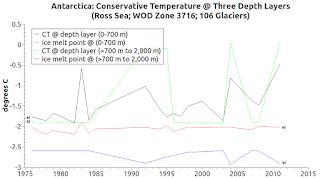 |
| Fig. 1 April 5, 2018 |
As the unprecedented warm winds from the south invade the Polar Vortex area at and near the North Pole, it diminishes the integrity of the spinning vortex, which causes sections of its very frigid arctic air to spin off and flow southward (Watching The Arctic Die, 2, 3).
Today for example, on April 7, 2018, at 10:00 AM it will be 40 deg. F at Nuuk, Greenland, at Anchorage, Alaska it will be 49 deg. F, but at Fort Worth, Texas will only be 37 deg. F.
 |
| Fig. 2 Breaking up |
Nuuk, Greenland is up near the Arctic Circle which is some 4,667 km or 2,900 miles to the North (Fig. 3).
Yes, near the Arctic Circle it will be warmer than some southern parts of the United States.
This, as this series has pointed out, is because sections of the Polar Vortex are being separated by warmer air incursions into the Arctic.
This incursion is a disruption which is melting the sea ice cover of the Arctic Ice Cap, but is also breaking pieces of the vortex off.
Those separated bands of cold Arctic air go south to make unseasonably frigid temperatures in Europe and the U.S.
 |
| Fig. 3 Warmer in Greenland than in Texas |
The spinning causes centripetal force which (when messed with) slings the sections out of the vortex like merry-go-rounds do to giggling kids at play on it; not knowing where in the circle they will end up when thrown off:
Under normal climate conditions, cold air is confined to the Arctic by the polar vortex winds, which circle counter-clockwise around the North Pole. As sea ice coverage decreases, the Arctic warms, high pressure builds, and the polar vortex weakens, sending cold air spilling southward into the mid-latitudes, bringing record cold and fierce snowstorms. At the same time, warm air will flow into the Arctic to replace the cold air spilling south, which drives more sea ice loss.(Wunderground, emphasis added). Or, as the government climate scientists put it:
‘Polar vortex’ is the new buzzword of 2014 for the millions of Americans learning about its role in producing record cold temperatures across the country. Meteorologists have known for years that the pattern of the polar vortex determines how much cold air escapes from the Arctic and makes its way to the U.S. during the winter.(Climate dot Gov). This knowledge helps explain that the Earth's climate is not getting colder as some have surmised by misinterpretation:
It’s happening again: In the dead of winter, warm air from the south is surging across the Arctic toward the North Pole.(Discover Magazine). This has been happening for quite a few years, but in recent years there have been increasing numbers of such events.
Today, weather models suggest that temperatures there have indeed soared to above freezing.
Meanwhile, cold polar air has spilled south into Eurasia and western North America. It’s almost as if someone left the Arctic’s refrigerator door open, allowing its frigid air to pour out and warm air to flow in.
[A] recent study shows that they are becoming more frequent and intense. In the study, scientists looked at winter air temperatures over the Arctic Ocean from 1893 to 2017. They found that since 1980, an additional six Arctic winter warming events have been occurring each winter at the North Pole, and they’re lasting about 12 hours longer, on average.
It is important to remember that this damage to the Arctic began about two decades after the Industrial Revolution began circa 1750.
That fossil fuel burning revolution caused Greenland to begin to melt in the late 1800's as shown by tide gauge records (Weekend Rebel Science Excursion - 54).
Once the Arctic Polar Vortex is completely destroyed the weather patterns caused by the damaged Global Climate System will be even less normal (The Damaged Global Climate System, 2, 3, 4, 5, 6).
The next post in this series is here, previous post in this series is here.
The new abnormal ...








